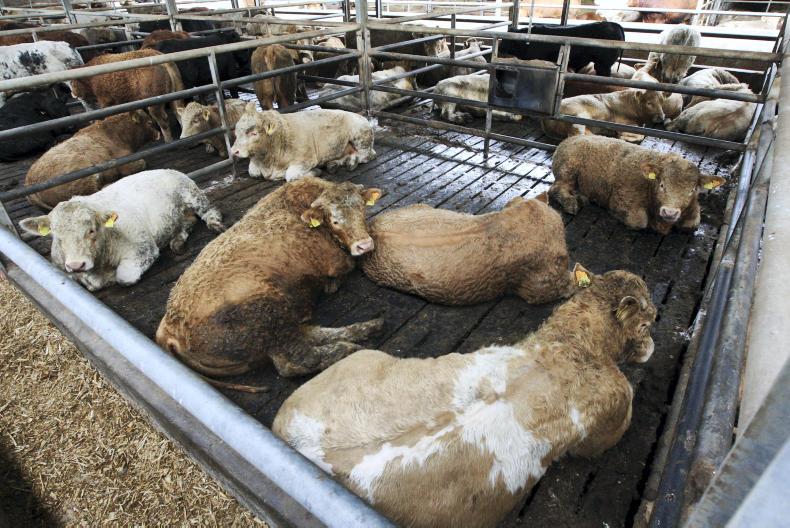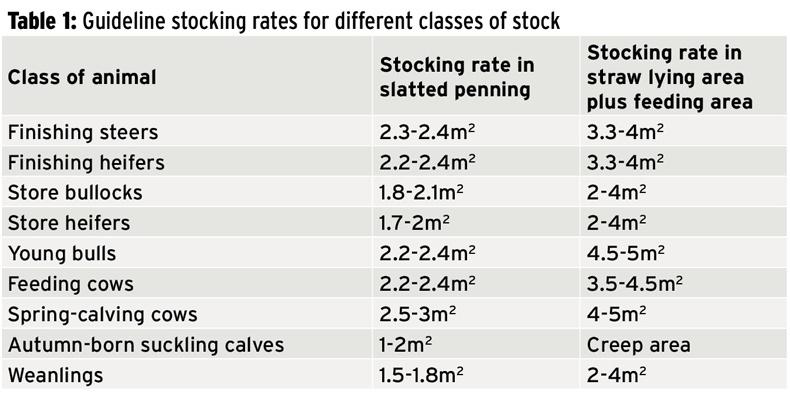The rate at which pens are stocked will have a direct influence on animal performance. If pens are overstocked, animal movement will be restricted, which will affect free access to feed and water. This can be a particular issue where there are shy feeders in a pen, or where animals are poorly matched on size and weight and there is bullying occurring.
Loose houses are less of a problem as the stocking rate here is generally lower with slatted houses typically the main offenders.
Table 1 details guideline stocking rate recommendations where feeding space is not an issue. If feeding space is an issue, then this will need to be factored into the number of animals that can be penned or trigger a switch to a different feeding system (ad-lib versus restricted).

If feeding space is limited and animals are being fed ad-lib to overcome these constraints, it is important to ensure that fresh feed is in front of animals at all times.
Growing animals
It is also important to consider the impact of growth in animals on the stocking rate in pens. For example, in a pen of eight finishing animals in a standard slatted pen gaining 1kg liveweight daily, these animals will be gaining in total over 50kg per week.
Over eight to ten weeks, there will be an additional 400kg to 500kg liveweight in the pen, or nearly the equivalent of another animal.
It is for this reason that you often hear a remark that finishing animals have performed better when one or two animals have been drafted from a pen with animals benefiting from the increased stocking rate allowance.
This should be taken into account at the start of the finishing period and particularly with bulls as mixing animals between pens is generally not an option.
Read more
Focus on winter indoor management
The rate at which pens are stocked will have a direct influence on animal performance. If pens are overstocked, animal movement will be restricted, which will affect free access to feed and water. This can be a particular issue where there are shy feeders in a pen, or where animals are poorly matched on size and weight and there is bullying occurring.
Loose houses are less of a problem as the stocking rate here is generally lower with slatted houses typically the main offenders.
Table 1 details guideline stocking rate recommendations where feeding space is not an issue. If feeding space is an issue, then this will need to be factored into the number of animals that can be penned or trigger a switch to a different feeding system (ad-lib versus restricted).

If feeding space is limited and animals are being fed ad-lib to overcome these constraints, it is important to ensure that fresh feed is in front of animals at all times.
Growing animals
It is also important to consider the impact of growth in animals on the stocking rate in pens. For example, in a pen of eight finishing animals in a standard slatted pen gaining 1kg liveweight daily, these animals will be gaining in total over 50kg per week.
Over eight to ten weeks, there will be an additional 400kg to 500kg liveweight in the pen, or nearly the equivalent of another animal.
It is for this reason that you often hear a remark that finishing animals have performed better when one or two animals have been drafted from a pen with animals benefiting from the increased stocking rate allowance.
This should be taken into account at the start of the finishing period and particularly with bulls as mixing animals between pens is generally not an option.
Read more
Focus on winter indoor management







 This is a subscriber-only article
This is a subscriber-only article







SHARING OPTIONS: